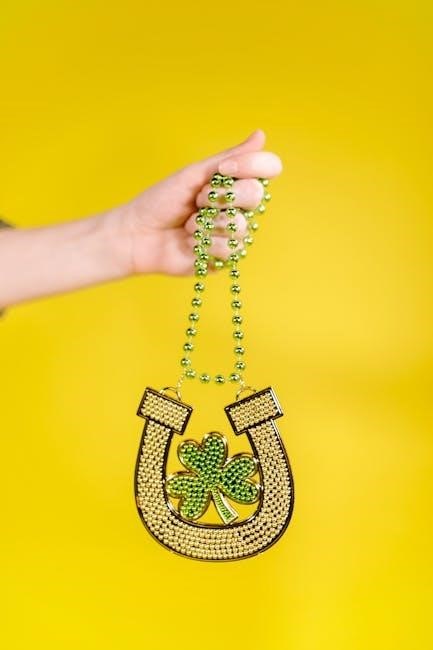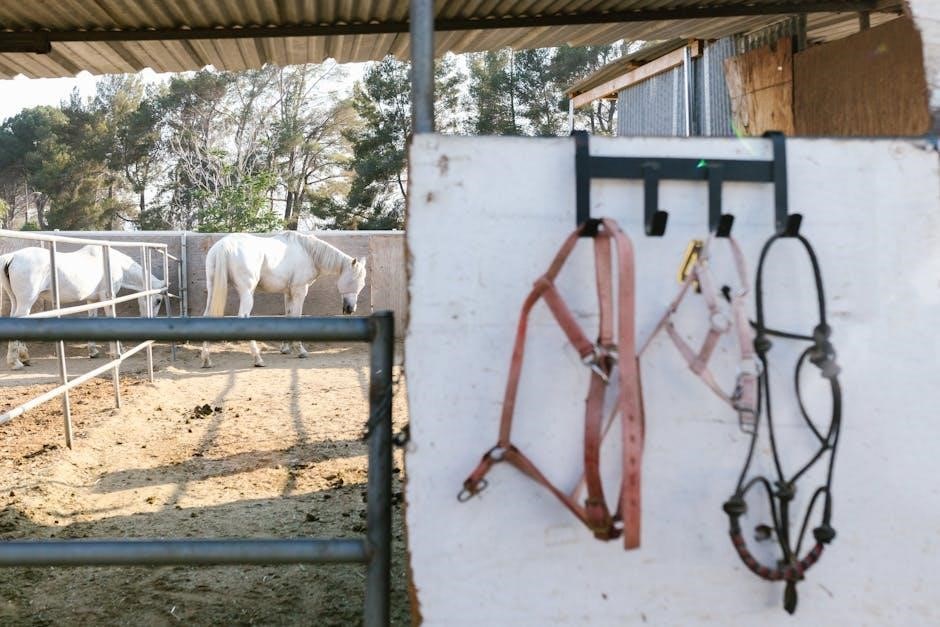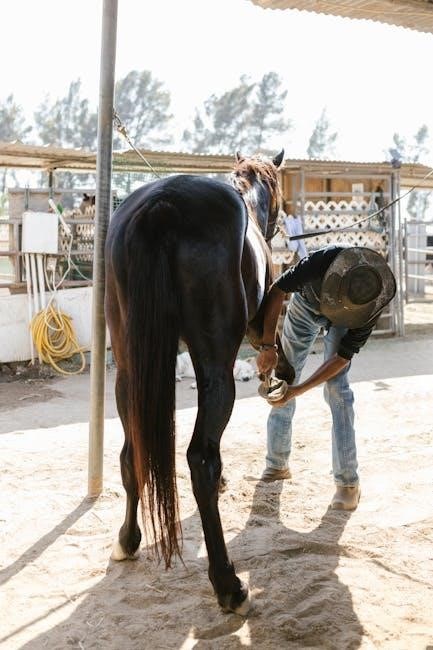Horseshoe pitching is a timeless outdoor game of skill and strategy, enjoyed by players of all ages. It involves tossing horseshoes at stakes 40 feet apart, aiming for accuracy and points. The game is simple yet challenging, requiring precision and technique. Governed by the National Horseshoe Pitchers Association (NHPA), it offers a fun, competitive experience for both casual and serious players.
Overview of the Game
Horseshoe pitching is a popular outdoor game where players toss horseshoes at stakes placed 40 feet apart. The objective is to score points by getting the horseshoes close to or encircling the stake. Governed by the National Horseshoe Pitchers Association (NHPA), the game requires skill, strategy, and precision. Players alternate turns, with each tossing two horseshoes per inning. The game is enjoyed casually and competitively, making it accessible to all ages and skill levels. Its simplicity and competitive nature have made it a beloved activity for outdoor gatherings and professional tournaments alike.
Historical Background
Horseshoe pitching has deep roots in American sports history, evolving from games played by early settlers. The modern version emerged in the late 19th century, with the National Horseshoe Pitchers Association (NHPA) forming in 1914 to standardize rules. The first official NHPA tournament occurred in 1920, establishing the game’s competitive framework. Its simplicity and accessibility have made it a beloved pastime for generations, with both casual and competitive play thriving across the U.S. and beyond. The game’s enduring appeal lies in its balance of skill and luck, fostering camaraderie and sportsmanship among players of all ages and skill levels.
Objective of the Game
The primary objective of horseshoe pitching is to toss horseshoes in such a way that they land as close as possible to the stake or entirely encircle it, known as a ringer. Players aim to score more points than their opponent by achieving ringers or having their horseshoes closer to the stake than their opponent’s. The game requires a combination of skill, accuracy, and strategy to outperform competitors.
Points are awarded based on the proximity of the horseshoes to the stake, with a ringer scoring the highest. Men typically pitch from 40 feet, while women and juniors may pitch from shorter distances, ensuring fairness and accessibility for all participants.

Official Rules of Horseshoe Pitching
Official rules govern the setup, equipment, and gameplay, ensuring fair competition. Courts must be 40 feet apart with stakes 14-15 inches high. Players pitch alternately, scoring based on proximity to the stake or achieving ringers. The National Horseshoe Pitchers Association (NHPA) oversees all regulations, ensuring consistency and fairness in both casual and tournament play. Adherence to these rules is essential for a proper game.
Equipment Requirements
- Horseshoes: Players use two horseshoes, typically made of metal, designed for tossing. They must meet National Horseshoe Pitchers Association (NHPA) standards.
- Stakes: Two metal stakes, 1 inch in diameter, are placed 40 feet apart. They should stand 14-15 inches above the ground and be slightly inclined toward each other.
- Pitching Box: A rectangular area, 6 feet wide, behind each stake. Players must pitch from within this box.
- Court Setup: The court is a level, rectangular area, 6 feet wide and 46 feet long. The ground should be loose dirt or sand for optimal play.
Proper equipment ensures fair and safe gameplay, adhering to official NHPA guidelines.
Court Setup and Dimensions
A horseshoe court is a level rectangular area measuring 6 feet wide and a minimum of 46 feet long. The two stakes are placed 40 feet apart, centered within the court. Each stake should extend 14 to 15 inches above the pit surface and be inclined no more than 3 inches toward each other. The pits, located around the stakes, are filled with loose dirt or sand to soften the impact of the horseshoes. The playing area behind each stake includes a pitching box, 6 feet wide, from which players must throw. Proper court setup ensures fair and consistent gameplay, adhering to official NHPA standards.
Player Eligibility and Categories
Players in horseshoe pitching are divided into categories based on age and skill level. Juniors must be under 18 years old, while seniors are typically 60 or older. Women and men compete separately, with women pitching at a shorter distance of 30 feet. Mixed doubles allow teams of one man and one woman. All players must meet eligibility criteria, such as age requirements, to participate in sanctioned events. The National Horseshoe Pitchers Association (NHPA) governs these categories, ensuring fair competition across all divisions. Proper classification helps maintain balanced and enjoyable gameplay for participants of all ages and skill levels.
Gameplay Basics
A game of horseshoe pitching consists of multiple innings, with players alternating turns; Each player throws both of their horseshoes during their turn, aiming for the stake. Points are scored based on the horseshoes’ proximity to the stake, with a “ringer” (a horseshoe encircling the stake) scoring the most. The player with the highest score at the end of all innings is declared the winner. Proper foot placement in the pitching box and adherence to throwing rules are essential for a valid pitch. The game emphasizes precision and consistency, making it enjoyable for both casual and competitive players.
Scoring System
The scoring system in horseshoe pitching rewards accuracy and proximity to the stake. A “ringer” earns 3 points, while a “leaner” near the stake scores 1 point. Penalties may deduct points for rule violations.
Points for Ringers
A “ringer” is achieved when a horseshoe lands around the stake, creating a perfect circle. This is the highest scoring throw, worth three points. To qualify as a ringer, the horseshoe must completely encircle the stake without touching it. If both players throw ringers, the points cancel out, resulting in no score for either. Ringers are rare and require exceptional skill, making them a thrilling moment in the game. Proper footwear and throwing technique are crucial to mastering this throw, as outlined in official NHPA guidelines.
Points for Leaners
A “leaner” occurs when a horseshoe lands within six inches of the stake but does not encircle it. Leaners are worth one point each. To qualify, the horseshoe must be the closest shoe to the stake compared to the opponent’s. If both players have a leaner, the points cancel out. Leaners are strategic throws, often aimed for when a ringer is difficult. Proper measurement tools are used to determine the distance, ensuring fair scoring. Leaners are a crucial part of the game, requiring precision and control to land near the stake without achieving a ringer.
Scoring Penalties
Scoring penalties in horseshoe pitching ensure fair play and adherence to rules. A foul shoe, such as an illegal throw or stepping over the foul line, results in no points for that throw. If a horseshoe lands outside the pit or exceeds the stake’s 72-degree angle, it is also penalized. Additionally, any shoe thrown out of order or after the opponent has already pitched incurs a penalty. These rules maintain the integrity of the game and prevent unfair advantages, ensuring that all players compete under the same conditions. Proper enforcement of penalties is essential for a balanced and enjoyable game.

Fouls and Penalties
Fouls in horseshoe pitching occur when a player violates rules, such as illegal throws or stepping over the foul line. Penalties include no points or disqualification.
Definition of a Foul Shoe
A foul shoe is defined as a horseshoe thrown improperly, typically due to a foot crossing the foul line or an illegal delivery. Such throws do not score points and are immediately removed. This rule ensures fair play and maintains the integrity of the game. Proper footwear and adherence to throwing techniques are essential to avoid fouls. Players must be mindful of their stance and release to comply with official regulations. A foul shoe is retrieved without affecting the opponent’s turn, keeping the game flowing smoothly. Understanding this rule is crucial for both beginners and experienced players to compete fairly.
Common Fouls and Their Consequences
Common fouls in horseshoe pitching include stepping over the foul line, illegal horseshoe designs, and improper shoe release. A foot crossing the foul line results in an invalid throw, while using unapproved horseshoes leads to disqualification. Improper releases, such as overhand throws, are also penalized. Consequences include loss of points for the offending throw and potential removal of the shoe from play. Repeated violations may lead to further penalties, as outlined by the NHPA. Understanding these fouls is essential for players to avoid penalties and maintain fair competition. Adhering to rules ensures a smooth and enjoyable game for all participants.
Protesting and Disputes
Protests regarding fouls, scoring, or rule violations must be made promptly to officials before the next pitch. The National Horseshoe Pitchers Association (NHPA) outlines that disputes should be documented and reviewed by tournament officials. If a player believes a foul was unfairly called, they can request a rules review. Officials have the final authority to resolve disputes, ensuring fair play. Players are encouraged to maintain sportsmanship, as excessive arguing may result in penalties. Proper documentation of violations helps prevent conflicts and ensures adherence to official rules, fostering a respectful and competitive environment for all participants.

Gameplay Mechanics
Horseshoe pitching involves tossing horseshoes at stakes 40 feet apart, with players taking turns to score points based on proximity and specific throws like ringers and leaners.
The Pitching Process
The pitching process in horseshoe pitching involves tossing the horseshoe at a stake 40 feet away. Players stand in a designated pitching box and throw underhand, aiming for the stake. A foul line marks the pitching area, and any horseshoe crossing it before release is ruled invalid. The goal is to land the horseshoe as close as possible to the stake or achieve a “ringer” by encircling it. Each player throws both horseshoes, and the process repeats for all participants. Proper technique and adherence to rules ensure fair play and maximize scoring opportunities.
Order of Play
The order of play in horseshoe pitching begins with a coin toss to determine who pitches first. Players alternate turns, with each player throwing both of their horseshoes during their turn. After both players have thrown, the inning is complete, and the next player or team takes their turn. The order of play remains consistent throughout the game unless agreed upon by all participants to change. This structured approach ensures fairness and maintains the flow of the game, allowing all players equal opportunities to score.
Inning Structure
An inning in horseshoe pitching consists of each player throwing both of their horseshoes in alternating turns. The player who wins the coin toss decides the order of play and pitches first. After the first player throws both horseshoes, the second player takes their turn. Once both players have thrown, the inning is complete, and the scores are tallied. This structured format ensures a fair and organized progression of the game. The inning structure is designed to maintain a consistent flow, allowing players to focus on their technique and strategy while competing to achieve the highest score.

Special Rules and Variations
Special rules adapt the game for different player groups, ensuring inclusivity and fairness. Junior, senior, women’s, and mixed doubles categories offer tailored regulations to suit various competitors.
Junior and Senior Rules
Junior and senior players benefit from modified rules to ensure accessibility and enjoyment. Juniors typically pitch from a shorter distance, often 25 feet, to accommodate developing skills. Seniors may also use a reduced pitching distance, usually 30 feet, to account for physical considerations. These adjustments maintain the game’s competitive spirit while promoting participation across age groups. Equipment and gameplay remain consistent with standard rules, ensuring a fair and engaging experience for all. Age-specific regulations are outlined by governing bodies to foster inclusivity and allow players of all ages to compete effectively.
Women’s Pitching Rules
Women’s pitching rules in horseshoes are designed to ensure fairness and competitiveness. Women typically pitch from a distance of 30 feet, shorter than the 40-foot distance for men. This adjustment allows for equal engagement and skill demonstration. The gameplay and scoring systems remain consistent with standard rules, emphasizing accuracy and technique. Women’s competitions follow the same objective of scoring points through ringers and leaners, with penalties applied for fouls. These rules promote inclusivity and equality, enabling women to participate actively in the sport while maintaining the integrity of the game.
mixed Doubles Rules
Mixed Doubles Rules
Mixed doubles in horseshoes combine teamwork and strategy, involving two-player teams with one male and one female. Teams alternate pitches, with each player throwing from their respective distances—men at 40 feet and women at 30 feet. Scoring follows standard rules, with points awarded for ringers and leaners. Communication and coordination are key, as teammates must work together to outscore opponents. Penalties for fouls apply equally, ensuring fair play. Mixed doubles promote camaraderie and competitive balance, making it a popular format for both recreational and competitive play.

Advanced Techniques
Advanced techniques in horseshoe pitching involve mastering spin control, precise aiming, and strategic scoring methods to enhance performance and outmaneuver opponents effectively.
Spin Techniques
Spin techniques in horseshoe pitching are essential for controlling the shoe’s rotation and trajectory. A well-executed spin ensures the horseshoe lands correctly, maximizing scoring potential. The most common spins include the “pendulum swing” and “modified spin,” which players use to compensate for distance and wind conditions. Proper grip and release are critical for achieving consistent spin. Advanced players often master multiple spin variations to adapt to different throwing conditions, enhancing their accuracy and performance. Spin techniques require practice to refine, as they directly influence the shoe’s behavior in flight and its final position around the stake.
Aiming Strategies
Aiming strategies in horseshoe pitching are crucial for achieving accuracy and consistency. Players often align their eyes with the stake, focusing on the target’s center. Proper foot placement and body alignment help maintain balance and control. Experienced pitchers visualize the horseshoe’s trajectory, adjusting for distance and spin. Wind and stake angles can influence aim, requiring subtle adjustments. A consistent release point and follow-through are vital for precision. Advanced strategies include compensating for horseshoe rotation and using visual markers to guide throws. Effective aiming enhances performance, making it a cornerstone of successful horseshoe pitching. Mastering these techniques requires practice and a keen understanding of the game’s mechanics.
Advanced Scoring Tactics
Advanced scoring tactics in horseshoe pitching involve strategic positioning and calculated risks to maximize points. Players often aim for high-value throws, such as ringers, while minimizing opponents’ scoring opportunities. Positioning the horseshoe close to the stake, even if not a ringer, can deny points to the opponent. Skilled players adapt their strategy based on the opponent’s strengths and weaknesses. Managing the scoreboard to maintain a lead while forcing the opponent into low-scoring throws is a key advanced tactic. These strategies require a deep understanding of the game and the ability to think several moves ahead, making them essential for competitive play.

Safety and Etiquette
Safety and etiquette are crucial in horseshoe pitching. Players must ensure proper footwear and maintain a safe distance during throws. Respect opponents, equipment, and the court to promote a positive and fair game environment.
Safe Pitching Practices
Safe pitching practices are essential to ensure a secure and enjoyable experience for all players. Always wear proper footwear to prevent slipping and maintain balance while throwing. Players should use controlled motions and avoid excessive force to minimize the risk of injury. Before each throw, inspect the horseshoes for damage or sharp edges. Be mindful of bystanders and ensure the throwing area is clear. Keep loose clothing and long hair tied back to avoid interference. Warm up before playing to prevent muscle strain. Never attempt a throw when others are near the stakes or pitching box. Always wait for the previous player to finish their turn before starting yours.
Respect for Opponents and Equipment
Respect for opponents and equipment is crucial in horseshoe pitching. Always maintain good sportsmanship, congratulating opponents on their throws and handling disagreements with grace. Avoid unsportsmanlike conduct, such as cheating or tampering with equipment. Treat horseshoes and stakes with care to prevent damage and ensure fair play. After each game, return equipment to its proper place and leave the court tidy. Shake hands or compliment opponents on their performance to foster a positive atmosphere. This mutual respect enhances the enjoyment of the game for everyone involved and upholds the traditions of the sport.
Horseshoe pitching is a rewarding game that combines skill, strategy, and camaraderie. Whether played casually or competitively, it offers fun and challenges for all participants, fostering lasting memories.
Final Thoughts
Horseshoe pitching is a game that blends simplicity with skill, making it accessible to everyone while still challenging even the most seasoned players. Its rich history and straightforward rules ensure that it remains a beloved activity across generations. Whether enjoyed casually in a backyard or competitively in tournaments, the game fosters camaraderie and sportsmanship. By following the official rules and practicing proper techniques, players can enhance their experience and appreciate the nuanced strategies involved. Horseshoe pitching is more than just a game—it’s a way to connect with others and enjoy the outdoors, making it a timeless and rewarding pastime for all.
Encouragement to Play
Horseshoe pitching is a game that’s easy to learn and fun to play, making it perfect for all ages and skill levels. Whether you’re a casual player or aiming to compete, the game offers a rewarding experience. It’s a great way to enjoy the outdoors, challenge yourself, and connect with others. The simple yet strategic nature of horseshoe pitching makes it an excellent activity for families, friends, or even solo practice. With its rich history and universal appeal, it’s a game that fosters camaraderie and healthy competition. Grab a pair of horseshoes and give it a try—you’ll quickly see why it’s a beloved pastime for so many!
